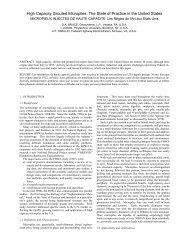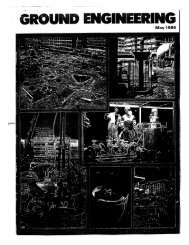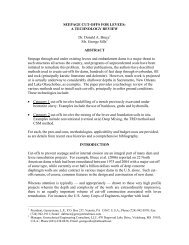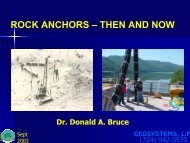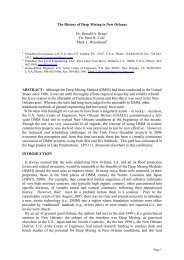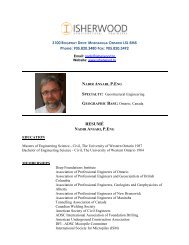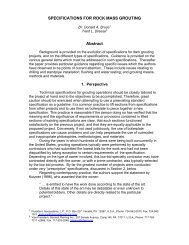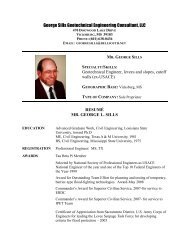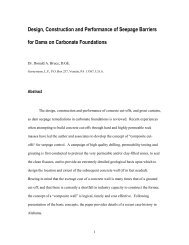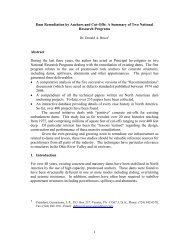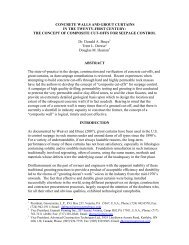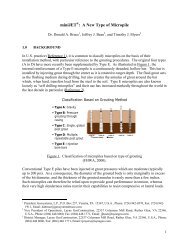high capacity and fully removable soil anchors - Geosystems, L.P.
high capacity and fully removable soil anchors - Geosystems, L.P.
high capacity and fully removable soil anchors - Geosystems, L.P.
Create successful ePaper yourself
Turn your PDF publications into a flip-book with our unique Google optimized e-Paper software.
An SBMA with four fixed anchor lengths of<br />
10 feet (i.e., overall fixed length of 40 feet), the<br />
efficiency factor for each 10-foot unit anchor<br />
(3 m) is:<br />
f eff = 1.6 x (3 m) -0.57<br />
= 0.86<br />
i.e., an SBMA with 4 unit <strong>anchors</strong> will be 2.3<br />
times more efficient than a conventional<br />
anchor with a single 40-foot fixed length (0.86 /<br />
0.37 = 2.3).<br />
This advanced design approach allows the<br />
fixed length of each unit anchor to be tailored<br />
for the <strong>soil</strong> conditions encountered at a<br />
particular depth. Hence a multiple of unit<br />
<strong>anchors</strong> may efficiently utilize various unit<br />
fixed length of 8 to 10 feet (2.5 to 3 m) with<br />
corresponding efficiency factors ranging from<br />
0.80 to 0.95.<br />
Approximately 60,000 unit <strong>anchors</strong> have been<br />
installed (approximately 1000 in the United<br />
States). About 68 investigation <strong>anchors</strong> have<br />
been loaded to failure, <strong>and</strong> ultimate capacities<br />
of 200 to 500 tonnes achieved in <strong>soil</strong>s<br />
(Simpson, 2001). The working capacities of<br />
SBMAs range typically from 80 to 200 tonnes,<br />
which is two to three times that of conventional<br />
anchor systems installed using the same<br />
construction techniques albeit with longer<br />
overall fixed lengths.<br />
Removable Anchor Systems<br />
The use of <strong>removable</strong> steel tensile members<br />
for temporary anchor applications has been<br />
developed since the mid 1970s. Two basic<br />
types of systems are available:<br />
• one that allows the removal of only the<br />
steel member from the free<br />
(debonded) length; <strong>and</strong><br />
• one that allows the removal of the<br />
steel member from the entire length of<br />
the anchor.<br />
Methods of removing the steel member from<br />
only the free length have been applied for<br />
many years by either unscrewing an anchor<br />
bar from the debonded length, or by providing<br />
some sort of a weakness in the str<strong>and</strong>s at the<br />
debonded/bonded length junction. Although<br />
simple in principle, the implementation of this<br />
system has been difficult, <strong>and</strong> as a result,<br />
much supposedly “<strong>removable</strong>” free length<br />
steel has been left in place over the past<br />
30 years. A limited number of specialist<br />
tendon suppliers <strong>and</strong> contractors now have<br />
“proven” <strong>removable</strong> systems available (Herbst,<br />
1997).<br />
The removal of both free <strong>and</strong> fixed length steel<br />
has until recently been extremely difficult to<br />
achieve. Loading the tendon to overcome<br />
grout/ground interface stress, which has<br />
typically been designed to factor of safety<br />
against bond failure in excess of 1.5, is<br />
practically impossible. Therefore, the limited<br />
number of <strong>removable</strong> systems available<br />
attempt to destroy or crack the grout column,<br />
thereby reducing tendon/grout bond <strong>capacity</strong><br />
prior to pull out. Rates of success of tendon<br />
removal using these methods vary<br />
considerably.<br />
For low <strong>capacity</strong> <strong>anchors</strong> (less than 20 tonnes)<br />
the use of an auger type system incorporated<br />
in the tensile member is readily available <strong>and</strong><br />
generally successful (“Chance” system). A<br />
recently developed method that allows<br />
complete removal of the fixed <strong>and</strong> free lengths<br />
of multiple str<strong>and</strong> tendons has been more<br />
consistently successful. This system,<br />
developed from the concept of the recovery of<br />
a climbing rope during rappelling, utilizes a<br />
looped str<strong>and</strong>, sheathed <strong>and</strong> greased over its<br />
entire length (Photograph 1).<br />
Load is transferred from the loop to a saddle<br />
<strong>and</strong> a short compression member within the<br />
corrugated sheath which in turn transfers the<br />
load to grout <strong>and</strong> the ground. The tails of the<br />
str<strong>and</strong> stick out of the borehole. The total<br />
elimination of bond between the steel str<strong>and</strong><br />
<strong>and</strong> the grout facilitates the removal of the<br />
entire length of str<strong>and</strong>. This concept was<br />
adapted to SBMAs by incorporating a series of<br />
loops with saddles positioned at staggered<br />
depths in the borehole (Stockhammer <strong>and</strong><br />
Trummer, 1995; Barley et al., 1999). During<br />
use, both tails are loaded simultaneously.<br />
During removal, one tail is loaded, <strong>and</strong> the<br />
str<strong>and</strong> slides around the saddle <strong>and</strong> pulls out<br />
of the borehole. Photograph 2 shows an<br />
extracted str<strong>and</strong>. The helical formation results<br />
from the friction along the saddle during<br />
pullout.




